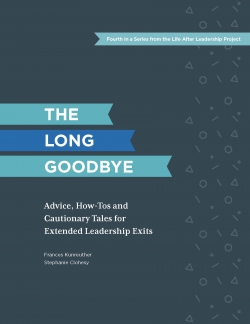The Long Goodbye: Advice, How-Tos and Cautionary Tales for Extended Leadership Exits
A decade ago, concern about the exit of the Baby Boomer generation from nonprofit leadership started to take shape. The dominant narrative which emerged predicted the sector was headed into a crisis – so many boomers would be leaving positions that organizations would be unable to fill top jobs unless something was done. In the end, economic and other realities made leadership transitions more routine, but the alarm helped organizations to prepare and plan for the exit of long-term leaders.
Now as they age, the Boomer exit is accelerating. With 10,000 baby boomers turning 65 each day and thinking about their next phase of life, the question has widened from the crisis in leadership to include what the boomers will do after they make their exit. Long-term nonprofit leaders say they are ready to leave their jobs; they want less responsibility and more flexibility, but they also want to continue to make a contribution. And many still need an income. So it is no surprise that more leaders are asking to stay in their organizations in another meaningful role and that organizations are wondering whether they should hang onto the talents of their exiting leader before letting them go completely.
Conventional wisdom from most executive transition experts, including most search firms, is that executive exits should be carefully planned and implemented with a clean and firm departure from the organization, and only a short period of overlap when the new leader arrives. Despite this prevailing advice, many organizations at least consider the “stay” option – that is keeping the long-term leader in the organization. The reasons for keeping the former leader in the organization vary. Often it is an emotional decision based on factors such as fears about the stability of the organization that the Board believes only the exiting leader can resolve; or it may be about loyalty that the Board feels towards the long-term leader. Offering a new position to the older leader can be a sign of respect and honor. And there are some boards that are used to having the leader make decisions and they simply go along with whatever the exiting executive proposes. Whatever the circumstances, most organizations reach a decision without fully assessing why and how to make it work.
Written by Frances Kunreuther and Stephanie Clohesy, this report is designed to help organizations and their leaders take practical steps to reflect on their assumptions, motives and needs in order to create workable solutions for choosing and managing an extended executive exit. The insights, advice and tools are all designed from a fundamental recognition that there are three sets of interests that need to be balanced in any solution –the Board representing the organization, the exiting leader, and the incoming leader. These are the key decision-makers about whether the departing director will stay in the organization after they leave positional power.

